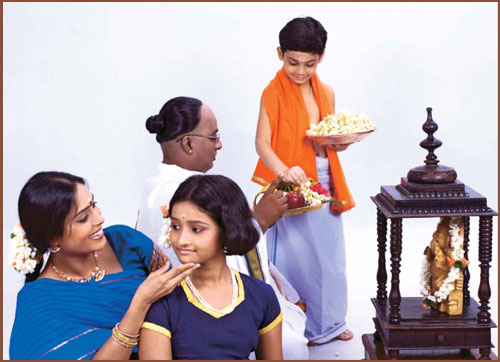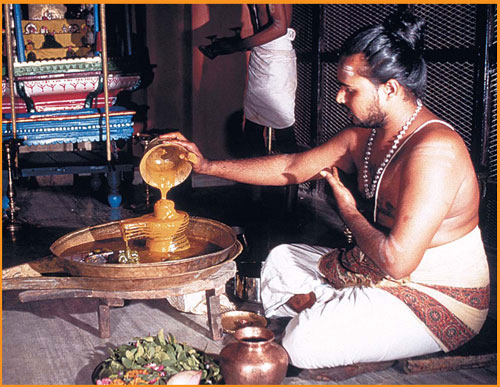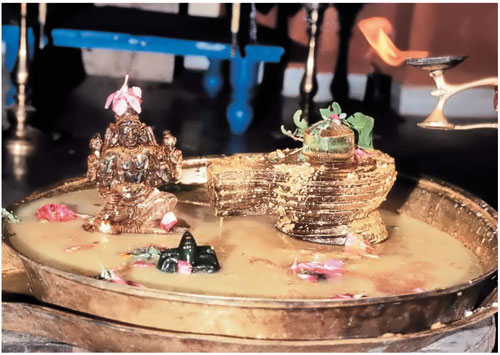Instructions for Establishing a Home Shrine
And Performing Puja to Lord Ganesha
 n performing the puja, preparation is of utmost importance—gathering flowers, cleaning the altar and puja tray, making ready the oil lamps and preparing the fruit and/or cooked food offering. It is common to chant a Ganesha mantra or softly sing devotional songs while performing these tasks. This quiets the mind and brings one’s awareness close to Him. Indeed, all this preparation is an integral part of worship.§
n performing the puja, preparation is of utmost importance—gathering flowers, cleaning the altar and puja tray, making ready the oil lamps and preparing the fruit and/or cooked food offering. It is common to chant a Ganesha mantra or softly sing devotional songs while performing these tasks. This quiets the mind and brings one’s awareness close to Him. Indeed, all this preparation is an integral part of worship.§
As you see in the photos, there are a number of traditional implements needed for the puja, such as a metal tray, holy water cups and spoons, ghee lamp, camphor lamp, as well as puja supplies, like holy ash and sandalwood paste. These are now available at Indian grocery stores, and online at www.minimela.com. For more information on setting up an altar, see Chapter 22, “Hindu Home Sanctuary” §
Before beginning the puja, check the altar to make sure all necessary articles are there, so that you don’t have to interrupt the flow of puja to get a missing item. Arrange all the items the same way for each puja so you can reach automatically when needed, with those most frequently used closest at hand. §
Hold the attitude that, as pujari, you are a servant of the Gods, a channel for the spiritual energies. Only thoughts of God are on your mind as you perform puja, thus enhancing the outpouring of divine blessings. Tradition provides a caution: you should never perform puja during or within 31 days of experiencing severe anger or other deep emotional upset, but it is all right to attend. Also, puja is not performed or attended by women during their menses, or by anyone who has a wound that is bleeding. Puja is a yoga, or link, between this and inner worlds. Therefore, you must be at your best in mood and emotion to assist in making this connection. Before performing puja, you should be freshly dressed, clean and undistracted by daily concerns. Having bathed beforehand, enter the shrine room and prostrate.§
The form of prostration differs for men and women. Men perform “eight-limbed obeisance,” ashtanga pranama, a fully prone pose in which hands, chest, forehead, knees and feet touch the ground. Women perform “five-limbed obeisance,” panchanga pranama, a kneeling pose in which hands, head and knees touch the ground (with ankles crossed, right over the left). §
When everything is ready, take your seat in a cross-legged posture in front of and to the left of the altar, facing the Deity but turned slightly to the right. Close your eyes, sit quietly for a moment and tune your nerve system to God Ganesha and the sacred puja you are about to perform. If others are attending, be careful not to sit directly in front of the Deity, thereby blocking their view of the altar. Generally one remains seated throughout the ritual, though in some shrines it may be more comfortable to stand during the arati or throughout the puja. When small children are in the home, the shrine room is locked so they do not disturb the contents. If a lockable room is not available, the altar is raised so as to be out of reach, and the puja is performed standing up. Those attending will usually sit during most of the ceremony, then stand during the final arati. However, this again may be left to individual discretion in consideration of the height of the shrine.§
Unlike the puja we are presenting in this chapter, some home pujas are long and elaborate. Here a priest performs a long Siva puja in an Indian home shrine during Mahasivaratri. §
Puja, the worship of a murti through water, lights and flowers in temples and shrines, is the Agamic counterpart of the Vedic yajna rite, in which offerings are conveyed through the sacred homa fire. These are the two great streams of adoration and communion in Hinduism, drawn from Hinduism’s two massive compendiums of revealed scripture—the Vedas and the Agamas.§
During the ritual, you will be making many offerings. Most offerings are made with the right hand, never just the left, though there are occasions when both hands are used. §
The offering of food is an important part of puja. Traditionally a simple dish of cooked rice is prepared especially for the Deity, with cooking utensils reserved for this purpose alone. If cooked food is not offered, then freshly cut fruit may be substituted. Keep the offering covered until the point in the puja when the pranas (life energies) of the food are offered to the Deity. Keeping the food covered helps to preserve purity and contain the pranas, which the Gods and devas can see, absorb, enjoy and reflect back to cleanse the auras of devotees. After the puja, the food offerings—along with holy ash (vibhuti), sacred water (tirtha), sandalwood paste (chandana), red powder (kumkuma) and flowers (pushpa)—are passed out and enjoyed as prasada.§
A recording of sacred chanting from the Vedas may be played softly before the puja begins. At the high point, as the arati is presented, loud drums and nagasvaras resound. As the sacraments are passed out by the pujari, the divine musical ragas are heard softly played on the vina, or Vedic chanting or devotional songs may be played.§
After the sacraments are passed out, encourage everyone to sit quietly for a while to enjoy the sannidhya, the ever-present feeling of the Divine, that the God, Gods, inner-plane gurus and devas suffuse in the shrine room. Such internalized worship naturally follows a puja. Those who perform daily japa will find this an ideal time for that sadhana. §
Internalizing worship in this way gives you and all members of the family strength to face the outside world, its daily challenges and, yes, school tests. Internalizing worship is the core of the Sanatana Dharma. It is the root, stem and blossom of the highest chakra, the 1,000-petalled lotus. It is the force that gives the strength to resist temptation, to turn others from their bad ways and to face up to and live through birth karmas, prarabdha karmas, that are brought with you in this life. It gives the courage to resist making new, especially unwanted, karmas to be faced at a later date. It gives the willpower needed in this Kali Yuga to survive. It gives the love which provokes the understanding to overlook and forgive, then forget. Finally, internalized worship gives the peace of mind, the shanti, in which all saints, sages, mahatmas and great seers dwell, in their jnana, their wisdom, of how things work in their universe of which we are a vital part.§
Many people are hesitant to do puja, specific, traditional rites of worship, because they feel they don’t have enough training or don’t understand the mystical principles behind it well enough. Most Hindus depend on the priests to perform the pujas and sacraments for them, or to train them to perform home puja and give them permission to do so through initiation, called diksha. However, simple pujas, such as this one, may be performed by anyone wishing to invoke grace from God, Mahadevas and devas. Mothers, daughters, aunts, fathers, sons, uncles, all may perform puja within their own home, and do, as the Hindu home is considered to be nothing less than an extension of the nearby temple.§
The Ganesha puja presented on the following pages consists of a series of Sanskrit chants to be intoned while performing the indicated actions and visualizations. Each chant is given in three forms, first in Sanskrit’s traditional Devanagari script, second in transliterated for those who speak English, and third in a freely-rendered English translation. Each translation is followed by detailed instructions to guide the pujari’s actions.§
The chants of the simple Ganesha puja given here are in Sanskrit, Hinduism’s ancient scriptural language. Time spent mastering the pronunciation is time well spent. Ideally, training is received personally from a priest, pundit or other person proficient in Sanskrit, so that you can chant the verses properly. Such a teacher will generally begin by teaching the alphabet and will offer training in reading in the Devanagari script, as well as the transliteration to help English-speaking students. Learning Sanskrit is not mandatory, and for those who do not have a teacher, we have a voice recording of this entire puja for learning the mantras properly. It is available at www.himalayanacademy.com/audio/chants/. A key to Sanskrit pronunciation for the transliteration system used in this puja is available online at www.himalayanacademy.com/resources/sanskrit/.§
Devotion During Sacred Rituals§
While correct chanting is important, the essential part of any puja is devotion. Without love of God and the Gods, outer performance is of little value. But with true devotion, even the simplest puja can be a profoundly sacred experience. Devotion is facilitated by the belief that you really are communing with the Divine through puja, that the Gods and devas do actually hear your prayers, enjoy your intonations and respond by sending blessings that purify your aura and protect your home. Though you can’t see them with your physical eyes, they are there nonetheless. As you perform or attend puja, visualize the Deity sitting before you, accepting your offerings, pleased to be in your company, delighted with your love and hospitality. Think of the God as a part of your family, a grand being who is concerned with your welfare. Through strong visualization and sincere devotion, your sensitivity to the darshan will grow and your relationship with the Deity will become strong and close.§
Cultivating devotion is called bhakti yoga. Satguru Sivaya Subramuniyaswami stressed its importance in this way, “Bhakti yoga is love on all levels of consciousness—physical, mental, emotional and spiritual. The greatest inhibiting factor in practicing bhakti yoga is the doubting, cynical, intellectual mind. Doubt and skepticism harden the heart and narrow the mind. The bloom of bhakti softens the heart and relaxes the intellect. Through bhakti yoga, the yoga of devotion, the combative mind becomes erased, absorbed into the consciousness of the One Self, the Being permeating all beings. With the help of devotion, you can soar within. You can not only pull away detachedly from unwholesome areas of the mind, but it is possible to keep yourself in an inward state of expanded consciousness.”§
Use and Care of the Shrine Room§
Keep the shrine spotlessly clean, and decorate it for festivals and special holy days. Visit your shrine before you leave the home, seeking blessings and protection as you leave its shelter, and go there again for purification upon returning. Worship in heartfelt devotion, so the Gods’ grace flows freely toward you and loved ones. Make the shrine a refuge for all family members, a haven where they can find peace and solace, where they can connect with the Gods, offer their praise and pray for practical needs. Train your children to worship in the shrine before each important event in life, such as a major exam at school or when faced with a personal challenge or problem.§


